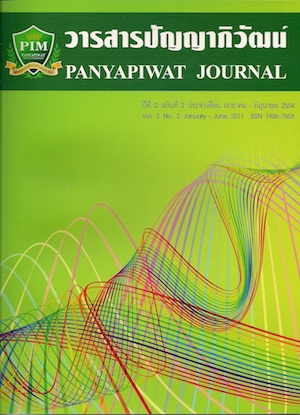Language used in 7-Eleven Convenient Store and Using Communicative Approach for Students at Panyapiwat Institute of Management
Main Article Content
Abstract
บทคัดย่อ
บทความนี้มีวัตถุประสงค์เพื่อเสนอประสบการณ์ในการสอนภาษาอังกฤษธุรกิจซึ่งเป็นภาษาอังกฤษ เฉพาะทางโดยการใช้การสอนการสื่อสารโดยใช้ภาษาอังกฤษในร้านสะดวกซื้อเซเว่น อีเลฟเว่นและร้านสะดวกซื้ออื่นๆ นอกจากนั้นผู้เขียนยังได้ใช้ทฤษฎีบทสรุปเชิงความคิดและการประยุกต์ใช้เหตุการณ์จริงในการสื่อสารภาษาอังกฤษให้กับนักศึกษาของสถาบันการจัดการปัญญาภิวัฒน์ ดังนั้นการสอนการสื่อสารภาษาอังกฤษให้กับนักศึกษา ผู้เขียนได้ใช้วิธีจำลองสถานการณ์ในห้องเรียนให้เป็นร้านสะดวกซื้อเซเว่น-อีเลฟเว่น โดยกำหนดให้นักศึกษาแสดงถึงเหตุการณ์ที่เกิดขึ้นจริงหรือเป็นการสร้างสถานการณ์ที่เกิดขึ้นในร้านระหว่างผู้มาซื้อสินค้ากับพนักงานขายสินค้า ซึ่งวิธีการดังกล่าวสามารถช่วยให้นักศึกษาฝึกภาษาอังกฤษได้ใกล้เคียงกับสถานการณ์จริงและ สามารถใช้ภาษาได้อย่างเหมาะสมและยังเป็นการพัฒนาให้เกิดทักษะในการเรียนของนักศึกษา เพราะนักศึกษาจะสามารถเรียนรู้การทำกิจกรรมและยังเป็นแนวทางสำหรับฝึกฝนตนเองได้ดี อีกทั้งยังเป็นประโยชน์ต่ออาจารย์ที่จะนำมาเป็นแนวทางในการสอนในชั้นเรียนต่อไป
คำสำคัญ : ภาษาในสังคม, การใช้ภาษาในร้านเซเว่นอีเลฟเว่น, บทสรุปเชิงความคิดและการนำไปใช้, การสอนภาษาอังกฤษในการสื่อสาร
Abstract
This article aims to share experience about Teaching Business English which is English for Specific Purpose (ESP) by using Communicative Language Teaching (CLT) in7-Eleven and other convenient stores. In addition, the writer applies Notional-Functional Syllabus and Communicative Approach in teaching English for students at Panyapiwat Institute of Management. To teach English to the students the writer applies Communicative Language Teaching or Communicative approach as a tool and sets up a situation in class to be 7-Eleven shop. Then he assigns a customer role and a staff role to the students so as to imitate the real situation when foreign customers are entering the shop. The method helps the students to practice speaking English as well as to develop their learning skill. Since the students will be the ones who do the jobs, they must learn how to do the task by themselves. In addition, the method is useful for the teachers who teach English in Panyapiwat Institute of Management to apply communicative approach for their English classes.
Keywords : Sociolinguistics, Language used in 7-Eleven, Notional–Functional Syllabus, Communicative Language Teaching
Article Details
I and co-author(s) certify that articles of this proposal had not yet been published and is not in the process of publication in journals or other published sources. I and co-author accept the rules of the manuscript consideration. Both agree that the editors have the right to consider and make recommendations to the appropriate source. With this rights offering articles that have been published to Panyapiwat Institute of Management. If there is a claim of copyright infringement on the part of the text or graphics that appear in the article. I and co-author(s) agree on sole responsibility.
References
Brown, H., D. (1994). Principles of language learning and teaching. New York: Addison Wesley Longman.
Brumfit, C., J. and Johnson, K. (1979). The communicative approach to language teaching. Oxford: University Press.
Harmer, J. (1983). The Practice of English language teaching. New York: Longman.
Hymes, D. (1972). On Communicative Competence, in J. B. Pride and J. Homes (eds). Sociolinguistics. Harmondsworth: Penguin.
Hutchinson, T., and Waters, A. (1991). English for specific purposes. Cambridge: Cambridge University Press.
Maley, A. (1982). Whatever Next? Some Recent Current in Foreign Language Teaching.Waiyu Jiaoxue Yu Yanjiu, 19 - 21.
Nunan, D. (1988). The Learner-centered curriculum. Cambridge: Cambridge University Press.
Nunan, D. (1988). Syllabus design. Oxford: University Press.Ohno, A. (2011). Communicative competence and communicative language teaching.From http://cicero.ubunkyo.ac.jp/lib/kiyo/fsell2002/ 25
Rebecca, L. and Robin, C. (1992). The Tapestry of language learning. Boston, MA: Heinle and Heinle.
Richards and Rodgers (1986). Approaches and methods in language teaching. Cambridge: Cambridge University Press.
Romaine, S. (1994). Language in society: An Introduction to sociolinguistics. New York: Oxford University Press.
Savignon, S. (1983). Communicative competence, theory and classroom practice. Reading, Mass: Addition-Wesley.
Shih, M. (1999). More than practicing language, communicative reading andwriting for Asian settings. TESOL Journal, 8(4), 20.
Spolsky, B. (1998). Sociolinguistics. ELT Journal, 54(3), 301.
Stockewell, P. (2007). Sociolinguistics: A resource book for students. New York: Routledge Avenue.
Wardhaugh, R. (2002). An Introduction to so-ciolinguistics. Oxford: Blackwell.
Wilkins, D.A. (1976). Notional syllabuses. Oxford: Oxford University Press.
William, L. (1983). Communicative language teaching: An introduction. Cambridge: Cambridge University Press.


